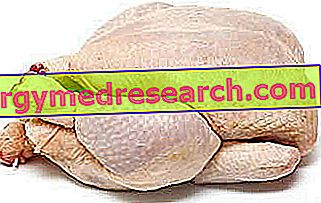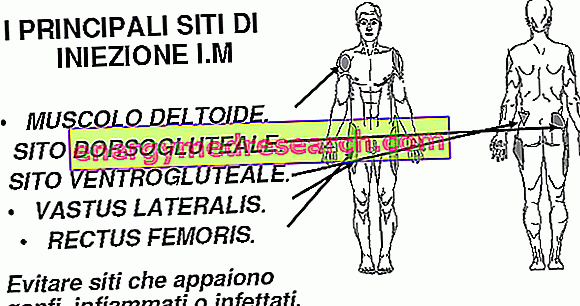Generality
Chicken meat is considered one of the leanest and healthiest foods of animal origin. In reality - although it is undoubtedly a product with a medium-low lipid content - as for all other foods derived from slaughter, even in chicken meat the presence of fat is variable; this variability is linked to cutting, processing, breeding method, age, sex and the subjective characteristics of the organism in question.

Chicken meat is among the most important in the meat trade; this is fundamentally due to two aspects of a totally different nature: the first concerns the price (low and sustainable even from the middle-low income brackets), the second concerns the health aspect (emphasized by the paltry content of triglycerides). It should also be remembered that chicken meat, more precisely the BREAST, is the most consumed food in dietary regimes for clinical nutrition and in those aimed at aesthetic culture or sport. It is also essential to remember that chicken meat is one of the few foods called hypoallergenic, which is why it is also used in elementary diets after the weaning of infants.
However, chicken meat is NOT risk-free or negative. This animal is also subject to parasitic infestations and viral or bacterial infections, as well as being subjected to intensive breeding and pharmacological abuse. It is therefore no coincidence that, among organic farming-farming products, chicken meat represents one of the most commercially successful foods (also thanks to the fact that, although it is more expensive than non-organic chicken, it still retains an affordable price ).
Chicken: This Unknown ...
Unfortunately, not everyone has had the privilege of spending their childhood with cows, chickens, rabbits and pigs. Anyone who is a stranger to country life will find it difficult to give an accurate description of the chicken; obviously I do not speak of the physical appearance of the animal, but of its biological nature! Is the chicken a species or a breed? Is it a boy or a girl? Is it fertile or sterile? Do you lay eggs? Let's try to make things a bit clearer.
The chicken, also called domestic chicken, according to the Linnea classification, is an animal of Asian origin belonging to the Order Galliformes, family Phasianidae, Genus Gallus, Species gallus, Subspecies domesticus ; in practice, according to his "identity card" the chicken should respond to the name Gallus gallus domesticus .
This bird has been accompanying the man for about 6, 000 years and its functions are different, but mainly food. However, a detail must not be overlooked, namely that Gallus gallus domesticus is NOT just a synonym of chicken, but also of rooster, hen, capon, and other breeding products. In short, we define:
- chick (very young male and female, up to 3-4 months old and just over half a kilogram in weight)
- wheat chicken (male and female from 5 months to one year, and from 700g to 1kg in weight)
- chicken (male and female until reaching sexual maturity, about 1 year and 1.5kg in weight)
- pollanca (female castrated before she starts laying eggs)
- cockerel (mature male up to 6 months)
- pullet (young oviparous female)
- hen (oviparous female who has already seen a breeding season)
- free-range rooster (male, up to 10 months)
- capon (2-month castrated male reaching 2.5kg).
In practice, the chicken is a specimen of young Gallus gallus domesticus (700-1500g) and still unable to reproduce (from which time it will be called rooster if male or hen if female). Not by chance, the name pollo derives from the Latin "pullus", that is a young animal. However, for some, chicken is also the chicken that has exhausted its ability to produce eggs.
Chicken Breeding: Correlations with the Healthiness of Meat
As with all foods, both animal and vegetable, chicken meat also varies its chemical and physical characteristics based on the age and life span of the organism. In this regard, if from the organoleptic point of view there is an abysmal qualitative difference between a free-range chicken and another intensively bred, it is more difficult to grasp the differences from a chemical / nutritional point of view.
Intensively and conventionally bred chicken is often blamed; this imputation does not derive so much from feed, whose composition more or less faithfully reflects the nutritional intake of a wild chicken, but from the intensive use of drugs. To explain this need, it must be considered that, given the density of the population bred (30-35kg on m2), the risk of diseases for chickens is very high. Suffice it to say that the competent authorities require the registration of the DAILY mortality rate, as well as the daily observation of the physical condition of the animals with documentation of anomalous deaths or behaviors / reactions of dubious healthiness. This means that very often the precautions for the prevention of the diseases of the raised chickens (respect for the biological void, ordinary disinfections and disinfestations, etc.) are not sufficient, which leaves NOTHING a few doubts! However, regardless of the controversy, let us remember that broiler chickens CAN be subjected to pharmacological treatments (including vaccines) provided that these actions are recorded and communicated to processing slaughterhouses that receive them. This is necessary because all drugs and active ingredients with pharmacological activity can leave unwanted residues in the meat. These are potentially harmful molecules for tumor induction, cardio-vascular diseases, fetal toxicity, etc. and, to make matters worse, they favor the induction of antibiotic resistance ALSO in humans. Therefore, any type of drug treatment that can be used must be prescribed and dosed ONLY by a veterinarian and it is necessary to respect the minimum suspension times to allow the disposal of the drug by the chicken and to avoid the risk of finding it in the meat.
The disciplinary therefore seems very clear, but probably not enough to be respected by thread and by sign. According to a survey recently carried out by "Altroconsumo", 85% of the meats showed TRACCE of antibiotics on a sample of 45 chickens found in markings between Milan and Rome. Obviously, we are not aware of either the concentrations or the chemical forms of the molecules involved; these are probably not very significant values.
On the other hand, as a "par condicio", we recall that the breeding of small animals (such as chickens, chickens, etc.) is scarcely affected by the use of anabolic hormones and accelerating development and growth; this is due not so much to the awareness or correctness of the breeders, but to the scarce convenience in the expense / yield ratio.
In practice, thanks to the intensive use of drugs in poultry farming, if on the one hand we are sure not to take steroid hormones and not to contract an infectious disease (salmonellosis, cholera, avian etc.), on the other we could select antibiotic-resistant strains able to seriously harm human health.
WARNING! It is a common opinion that chicken meat raised at home is much healthier than commercial meat; unfortunately, also in this case it is necessary to make a distinction between "conscious" self-production and "spannometric" self-production. In the first case, chicken farmers respect all the sanitary and veterinary rules, avoiding the various risks of contracting infectious diseases such as salmonellosis, leptospirosis, etc. Furthermore, they feed the animals correctly, use materials of NOT contaminated or dangerous fixtures, and protect the chickens from exposure to toxic molecules. In the second case, on the other hand, the risks to the health of the animals and, consequently, also to humans can significantly increase. Examples are clear: the absence of veterinary checks, the ignorance of clinical signs indicating a pathological condition of the animals, the use of carcasses of dubious origin for feeding the chickens, the building of chicken coops with friable eternit contained asbestos and the feathering of pests during pesticide treatments in the countryside.
With regard to this last factor, only 30-40 years ago, when legislation and regulations were less severe and articulated, letting the chickens scratch around during chemical treatments given to orchards could witness a phenomenon that was nothing short of impressive: namely the production of shell-free eggs that stopped when pesticide exposure stopped.
Nutritional Features
Chicken meat is considered among the leanest on the market; in reality, this is a partially acceptable conviction.
First of all, we point out that the most abundant triglyceride anatomical portion of the chicken is the skin. In this animal, in fact, a good part of the adipose tissue is concentrated in the integumentary apparatus and is easily detachable with skinning and cooking. With regard to chicken meat properly so-called (therefore devoid of skin), with the due differences attributable to the cut, it is possible to observe how the quantity of intramuscular lipids is decidedly moderate compared to the tissues of other animals. More specifically, variations are observed ranging from 6g / 100g of lipids in meat without raw skin, with an average of 3.6g / 100g. Considering the cuts of meat with raw skin, instead, fluctuations emerge ranging from 14g / 100g (of the wing), with an average of 10.6g / 100g.
Also with regard to cholesterol, between cuts without skin and those with skin, significant differences are noted, equal to about 15 / mg on 100g of edible portion. The average of cholesterol in chicken with raw skin is in fact 93mg / 100g, while in chicken without raw skin it is 75mg / 100g. As a general rule, chicken meat (even if with skin) never exceeds the 100mg / 100g of product (EXCLUDED FRACTURES !!!).
The breakdown of fatty acids is in favor of saturates compared to polyunsaturated and monounsaturated compounds individually; however, adding these last two, we note a prevalence of the total unsaturated on the saturated.
From a strictly nutritional point of view, the function of chicken meat is to provide high biological value proteins in the diet. Like other animal proteins, in fact, even those of chicken possess all the essential amino acids in more than satisfactory quantities. The amino acid considered "limiting" is tryptophan, while the 3 most present are: glutamic acid, aspartic acid and lysine. The protein intake of chicken meat is on average between 19.0 and 19.4g / 100g of edible part, while the richest peptide cut is undoubtedly the breast, with more than 23g / 100g.
Chicken meat does not contain carbohydrates and caloric intake is mainly determined by proteins and fats. Also in this respect, there are significant differences between the various cuts but, on average, the one with raw skin brings 171kcal / 100g and the other (without raw skin) 110kcal / 100g. It is deducible that, being thinner, the cut with the lower caloric intake of chicken meat is just the raw breast without skin: 100kcal / 100g.
As far as mineral salts are concerned, chicken meat is not among the most valuable. Usually, with the introduction of meat we intend to favor the supply of bio-available iron, rich in this kind of food. However, in this case we can see an average of about 0.6-0.7mg of iron per 100g of edible portion and, in the famous breast, only 0.4mg / 100g. Potassium and phosphorus are instead present in satisfactory quantities.
Last but not least, vitamins. In fact there is not much to say, except that those contained in "interested" portions in chicken are: Niacin (vit. PP), with 5.00-5.80 mg / 100g of edible portion (with and without skin), and cyanocobalamin (vit. B12).
The nutritional considerations on sausages (or other derivatives) of chicken meat are referred to in the article: sausages.
Chicken-Based Video Recipes
Baked stuffed chicken with potatoes - no added fat
X Problems with video playback? Reload from YouTube Go to Video Page Go to Video Recipes Section Watch the video on youtubeSee also: video recipes based on chicken breast



